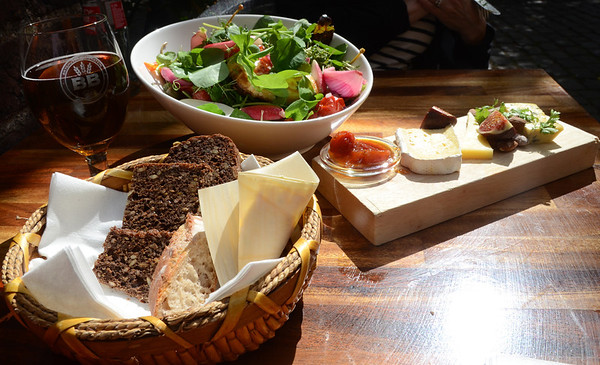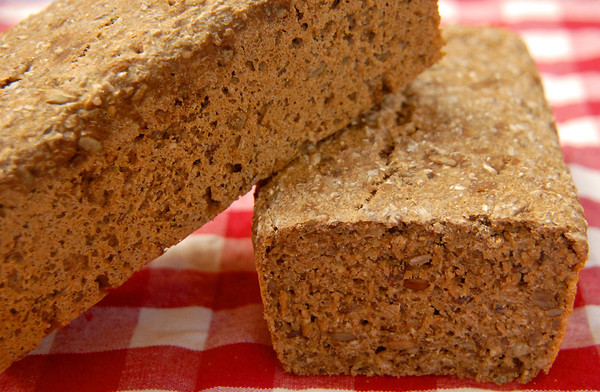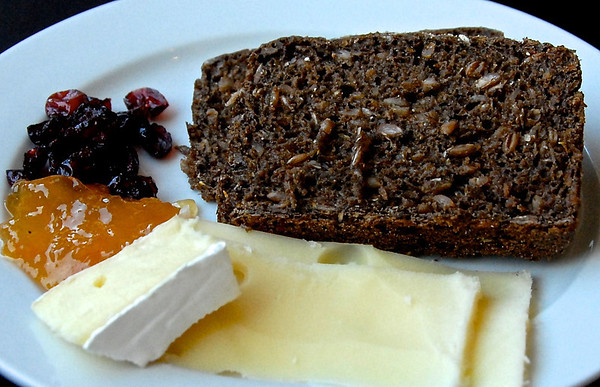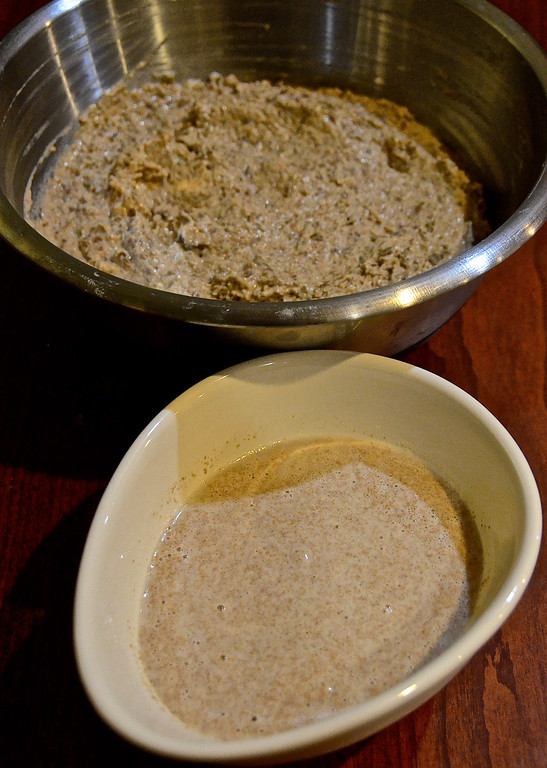
Tasty Danish lunch featuring brown bread
At the end of summer I spent two idyllic weeks in the magical, Scandinavian land known as the Kingdom of Denmark. Vikings, Shakespeare’s Hamlet and Hans Christian Anderson as well as Legos, Lars von Trier and Chef Rene Redzepi have all called this series of lovely islands home. Frequently ranked as the world’s happiest country, Denmark has the world’s highest minimum wage, a high per capita income, environmental and historic preservation, free university education and universal healthcare. It’s a country of breathtaking architecture, influential designers, renowned writers, fervent cyclists, golden fields, rugged coastlines and amazingly fresh, tasty, wholesome foods.

Two loaves of Danish brown bread
Weeks after returning from vacation I remain wildly smitten with Denmark. Top among my obsessions are Danish pastries, films, mystery writers, the TV series Forbrydelsen, Ilse Jacobsen rain boots and the country’s dark, nutty brown bread. I first tried this hearty specialty six years ago in Sweden. There it’s known simply as Danish bread. In Denmark it’s called rugbrød, a flavorful, dark rye bread chocked full of whole grains and fiber. Danes eat it at breakfast. I ate it every chance that I could get.

Typical breakfast in Copenhagen includes a slice of brown bread
Back in the States it’s been difficult not only to find a recipe but also the ingredients for rugbrød. In spite of being in New York City where I have access to a large, global pantry, I ended up buying barley malt syrup and cracked rye online. As for the recipe, I cobbled together one that’s loosely based upon Mogen’s Rye Bread from Camilla Plum’s The Scandinavian Kitchen (Kyle Books, 2011). Unlike Plum’s creation, mine does not use a sourdough starter; because my hunger for Danish brown bread was tremendous, I didn’t want to wait over five days for the starter to ferment. Instead I used a poolish sponge or starter, which only requires five hours to leaven.

Brown bread batter and dough
In the following recipe you can replace the poolish with sourdough starter. Likewise, you can eliminate the beer and just use water. I prefer a mix of seeds but that’s also a baker’s choice. Although I did make this with light rye flour, I suspect that dark rye would be even better. Serve the bread with good quality butter, cheese, apple butter or smoked fish.
DANISH BROWN BREAD
Makes 2 (8″ x 4″) loaves
for the starter:
2 cups whole wheat flour
2 cups water
1/8 teaspoon active dry yeast
for the bread:
1 1/4 cups starter
2 cups cracked rye
2 cups rye flour
2 cups whole wheat flour
3/4 cup roasted sunflower seeds
1/4 cup flax seeds
1 tablespoon coarse sea salt
1 cup beer (lager)
2 cups water, plus more if needed
2 tablespoons barley malt syrup
To make the starter, mix the flour, water and yeast in a bowl. Cover with cling wrap and allow the mixture to ferment for five hours at room temperature. Note that, once it’s finished fermenting, you can refrigerate the starter for up to three days.
Measure out 1 1/4 cups of starter. Place that along with the cracked rye, rye flour, wheat flour, sunflower and flax seeds, salt, beer, 2 cups of water and barley malt syrup in a large bowl. Mix together until well combined. Cover and allow the dough to rest for 30 minutes.
Grease two 8″ x 2″ loaf pans and set aside.
After 30 minutes check the dough’s consistency. If it seems overly dry and unyielding, stir in up to 1/4 cup of water; you want the dough to be firm but also soft. Using a spatula, spoon equal amounts of dough into each loaf pan. Smooth out the tops so that the dough is distributed evenly. Cover the pans with a clean, damp dishcloth and allow the loaves to rise for 12 hours at room temperature.
Preheat the oven to 325 degrees Fahrenheit.
Uncover the loaves and, using a toothpick or skewer, poke 20 or so holes, from top to bottom, in each loaf. This will stop the loaves from forming air pockets and, subsequently, holes in the bread.
Bake for 1 1/4 hours, until a firm crust forms on top and the loaves begin to separate from the sides of the pan. Remove and cool the loaves in their pans for 5 minutes before removing and placing them on wire racks to cool completely.